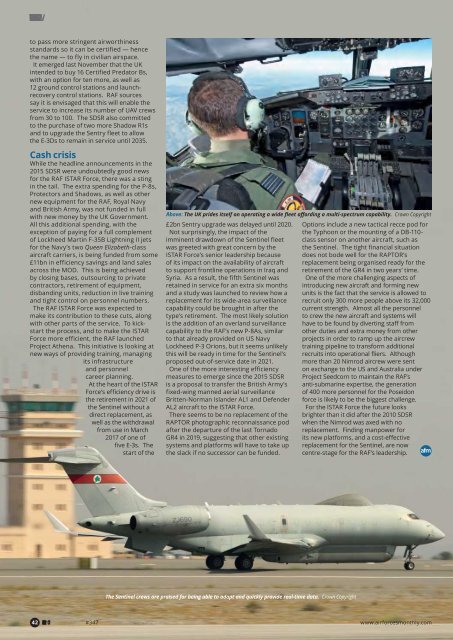Airforces Monthly - February 2017
Create successful ePaper yourself
Turn your PDF publications into a flip-book with our unique Google optimized e-Paper software.
UNITED KINGDOM: ISTAR REVIEW<br />
to pass more stringent airworthiness<br />
standards so it can be certified — hence<br />
the name — to fly in civilian airspace.<br />
It emerged last November that the UK<br />
intended to buy 16 Certified Predator Bs,<br />
with an option for ten more, as well as<br />
12 ground control stations and launchrecovery<br />
control stations. RAF sources<br />
say it is envisaged that this will enable the<br />
service to increase its number of UAV crews<br />
from 30 to 100. The SDSR also committed<br />
to the purchase of two more Shadow R1s<br />
and to upgrade the Sentry fleet to allow<br />
the E-3Ds to remain in service until 2035.<br />
Cash crisis<br />
While the headline announcements in the<br />
2015 SDSR were undoubtedly good news<br />
for the RAF ISTAR Force, there was a sting<br />
in the tail. The extra spending for the P-8s,<br />
Protectors and Shadows, as well as other<br />
new equipment for the RAF, Royal Navy<br />
and British Army, was not funded in full<br />
with new money by the UK Government.<br />
All this additional spending, with the<br />
exception of paying for a full complement<br />
of Lockheed Martin F-35B Lightning II jets<br />
for the Navy’s two Queen Elizabeth-class<br />
aircraft carriers, is being funded from some<br />
£11bn in efficiency savings and land sales<br />
across the MOD. This is being achieved<br />
by closing bases, outsourcing to private<br />
contractors, retirement of equipment,<br />
disbanding units, reduction in live training<br />
and tight control on personnel numbers.<br />
The RAF ISTAR Force was expected to<br />
make its contribution to these cuts, along<br />
with other parts of the service. To kickstart<br />
the process, and to make the ISTAR<br />
Force more efficient, the RAF launched<br />
Project Athena. This initiative is looking at<br />
new ways of providing training, managing<br />
its infrastructure<br />
and personnel<br />
career planning.<br />
At the heart of the ISTAR<br />
Force’s efficiency drive is<br />
the retirement in 2021 of<br />
the Sentinel without a<br />
direct replacement, as<br />
well as the withdrawal<br />
from use in March<br />
<strong>2017</strong> of one of<br />
five E-3s. The<br />
start of the<br />
Above: The UK prides itself on operating a wide fleet affording a multi-spectrum capability. Crown Copyright<br />
£2bn Sentry upgrade was delayed until 2020.<br />
Not surprisingly, the impact of the<br />
imminent drawdown of the Sentinel fleet<br />
was greeted with great concern by the<br />
ISTAR Force’s senior leadership because<br />
of its impact on the availability of aircraft<br />
to support frontline operations in Iraq and<br />
Syria. As a result, the fifth Sentinel was<br />
retained in service for an extra six months<br />
and a study was launched to review how a<br />
replacement for its wide-area surveillance<br />
capability could be brought in after the<br />
type’s retirement. The most likely solution<br />
is the addition of an overland surveillance<br />
capability to the RAF’s new P-8As, similar<br />
to that already provided on US Navy<br />
Lockheed P-3 Orions, but it seems unlikely<br />
this will be ready in time for the Sentinel’s<br />
proposed out-of-service date in 2021.<br />
One of the more interesting efficiency<br />
measures to emerge since the 2015 SDSR<br />
is a proposal to transfer the British Army’s<br />
fixed-wing manned aerial surveillance<br />
Britten-Norman Islander AL1 and Defender<br />
AL2 aircraft to the ISTAR Force.<br />
There seems to be no replacement of the<br />
RAPTOR photographic reconnaissance pod<br />
after the departure of the last Tornado<br />
GR4 in 2019, suggesting that other existing<br />
systems and platforms will have to take up<br />
the slack if no successor can be funded.<br />
Options include a new tactical recce pod for<br />
the Typhoon or the mounting of a DB-110-<br />
class sensor on another aircraft, such as<br />
the Sentinel. The tight financial situation<br />
does not bode well for the RAPTOR’s<br />
replacement being organised ready for the<br />
retirement of the GR4 in two years’ time.<br />
One of the more challenging aspects of<br />
introducing new aircraft and forming new<br />
units is the fact that the service is allowed to<br />
recruit only 300 more people above its 32,000<br />
current strength. Almost all the personnel<br />
to crew the new aircraft and systems will<br />
have to be found by diverting staff from<br />
other duties and extra money from other<br />
projects in order to ramp up the aircrew<br />
training pipeline to transform additional<br />
recruits into operational fliers. Although<br />
more than 20 Nimrod aircrew were sent<br />
on exchange to the US and Australia under<br />
Project Seedcorn to maintain the RAF’s<br />
anti-submarine expertise, the generation<br />
of 400 more personnel for the Poseidon<br />
force is likely to be the biggest challenge.<br />
For the ISTAR Force the future looks<br />
brighter than it did after the 2010 SDSR<br />
when the Nimrod was axed with no<br />
replacement. Finding manpower for<br />
its new platforms, and a cost-effective<br />
replacement for the Sentinel, are now<br />
centre-stage for the RAF’s leadership.<br />
The Sentinel crews are praised for being able to adapt and quickly provide real-time data. Crown Copyright<br />
42 FEBRUARY <strong>2017</strong> #347 www.airforcesmonthly.com


